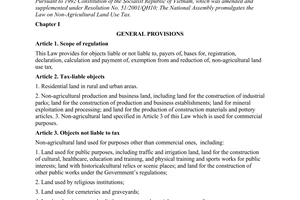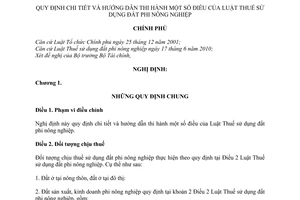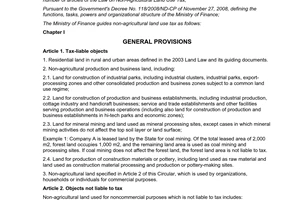Nội dung toàn văn Decree No. 53/2011/ND-CP detailing and guiding a number of articles of the law
|
THE
GOVERNMENT |
SOCIALIST
REPUBLIC OF VIET NAM |
|
No. 53/2011/ND-CP |
Hanoi, July 01, 2011 |
DECREE
DETAILING AND GUIDING A NUMBER OF ARTICLES OF THE LAW ON NON-AGRICULTURAL LAND USE TAX
THE GOVERNMENT
Pursuant to the December 25. 2001 Law on Organization of the Government;
Pursuant to the June 17, 2010 Law on Non-Agricultural Land Use Tax;
At the proposal of the Minister of Finance,
DECREES:
Chapter I
GENERAL PROVISIONS
Article 1. Scope of regulation
This Decree details and guides a number of articles of the Law on Non-Agricultural Land Use Tax.
Article 2. Tax-liable objects
Objects liable to non-agricultural land use tax are defined in Article 2 of the Law on Non-Agricultural Land Use Tax, specifically as follows:
1. Residential land in rural and urban areas.
2. Non-agricultural production and business land specified in Clause 2. Article 2 of the Law on Non-Agricultural Land Use Tax. including:
a/ Land for construction of industrial parks, including industrial clusters, industrial parks. export-processing zones and other production and business /ones, to which a common land use regime is applied:
b/ Land for construction of production and business establishments, including industrial production, collage industry and handicraft businesses, service and trade establishments and other facilities in support of production and business operations (including also land for construction of production and business establishments in hi-tech parks and economic zones):
c/ Land for mineral mining and land used as mineral processing sites, except cases in which mineral mining activities do not affect the top soil layer or the land surface;
d/ Land for production of construction materials or pottery, including land used as raw materials and land used as construction material processing and production sites or sites for making pottery.
3. Non-agricultural land defined in Article 3 of this Decree which is used by organizations, households or individuals for commercial purposes.
Article 3. Objects not liable to tax
Non-agricultural land used for noncommercial purposes specified in Article 3 of the Law on Non-Agricultural Land Use Tax are not liable lo tax, specifically:
1. Land used for public purposes, including:
a/ Traffic and irrigation land, including land for construction of roads, bridges, sluices. pavements, railways, airport and airfield infrastructure, including also land planned for construction of airports or airfields under phased investment projects which have been approved but not yet implemented, land for construction of water supply systems (excluding water plants), water drainage systems, irrigation work systems, dikes and dams, and land within traffic and irrigation safety corridors;
b/ Land for construction of public cultural. healthcare, education and training, physical training and sport facilities, including crèches, schools, hospitals, marketplaces, parks, flower gardens, children's recreation centers, squares, cultural works, post-cultural spots of communes, wards and townships, monuments, commemorative stelae, museums, functional rehabilitation institutions for persons with disabilities, vocational training schools, drug detoxification institutions, reformatories. dignity restoration camps and nursing homes for elderly persons and disadvantaged children;
c/ Land with historical and cultural relics or scenic places which have been ranked or placed under protection under decisions of People's Committees of provinces and centrally run cities (below referred to as provincial-level People's Committees);
d/ Land for construction of other public works, including land used for public-utility purposes in urban centers and rural residential areas; land for construction of common-utility infrastructure facilities in industrial parks, hi-tech parks and economic zones under approved plans; land for construction of power transmission lines, communication networks, petrol, oil and gas pipelines and their safety corridors; land of power stations, irrigation reservoirs and dams; land of funeral halls and crematories; land of landfills, garbage dumping grounds and waste treatment complexes approved by competent state agencies.
2. Land used by religious institutions, including land of pagodas, churches, oratories, chancels, monasteries, religious training institutions, offices of religious organizations and other religious establishments permitted by the State.
3. Land used as cemeteries and graveyards.
4. Land under rivers, canals, ditches, streams and special-use water surface;
5. Land with communal houses, temples, hermitages, clans' worship halls, including land areas for building these works and their premises;
6. Land for construction of working offices and non-business works, including;
a/ Land of working offices of state agencies, political organizations, socio-political Organizations and public non-business organizations; offices of Vietnam-based diplomatic representative missions and foreign consulates and intergovernmental international organizations entitled to privileges and immunities like foreign diplomatic representative missions in Vietnam;
b/ Land of economic, cultural, social, scientific and technological and diplomatic non-business establishments of state agencies, political organizations, socio-political organizations and public non-business organizations.
7. Land used for defense and security purposes, including:
a/ Land of barracks and army camps;
b/ Land of military bases:
c/ Land of national defense works, battlefields and other special defense and security works;
d/ Land of military stations and ports:
e/ Land of industrial and science and technology works in direct service of national defense and security:
f/ Land of warehouses of the people's armed force units;
g/ Land of firing ranges, drill grounds. weapon testing grounds and weapon disposal sites;
h/ Land of guest houses, public-duty houses, competition halls, gyms and other facilities within barracks and camps of the people's armed force units;
i/ Land of prisons, detention houses, educational institutions and reformatories managed by the Ministry of National Defense or the Ministry of Public Security:
j/ Land of other combat works and defense and security works specified by the Government.
8. Non-agricultural land for construction of works of cooperatives engaged in agricultural or forestry production, aquaculture and salt-making: land in urban areas which is used for construction of glasshouses and other buildings for farming purposes, including cases in which crops are not planted directly on land; land for construction of farms for raising livestock, poultry and other animals as permitted by law; land for construction of research and testing farms and stations in the agriculture, forestry and fishery sectors; land for construction of plant and animal nurseries: land for construction of households' and individuals' warehouses for storing farm produce, plant protection drugs, fertilizers and agricultural machines and tools.
Chapter II
TAX BASKS. TAX REGISTRATION, DECLARATION. CALCULATION AND PAYMENT AND TAX EXEMPTION AND REDUCTION
Article 4. Taxable land area
Taxable land area is the area of non-agricultural land actually used.
1. In case a taxpayer has the right to use many land plots within a province or centrally run city, the taxable land area is the total area of taxable land plots.
2. For residential land of a multi-story building with many users or a condominium, including those with areas for both dwelling and commercial purposes, the taxable land area of each organization, household or individual shall be determined to be equal to the allocation coefficient multiplied by the area of the apartment (work) used by such organizations, household or individual.
|
Allocation coefficient applicable to a building or condominium without basement |
= |
Construction land area of the building or condominium |
|
Total area of apartments used by organizations households and individuals |
|
Allocation coefficient applicable to a building or condominium with a basement |
= |
Construction land area of the building or condominium |
||
|
Total area of apartments used by organizations, households and individuals (ground sections) |
+ |
50% of the basement area used by organizations, households and individuals |
||
|
Allocation coefficient applicable to an underground work |
= |
50 x Ground land area corresponding to the underground work |
|
Total area of the underground work used by organizations, households and individuals |
The area of the apartment (work) used by an organization, household or individual is the floor area actually used by such organization, household or individual stated in the sale/ purchase contract or the certificate of the right to use land or own houses or assets attached to land (the certificate).
Article 5. Price of a square meter of taxable land
1. The price of a square meter of taxable land is the price of land based on the use purpose of the taxable land plot which is set by the provincial-level People's Committee and shall be kept unchanged for a 5-year period stating on January 1, 2012.
2. In case of changing taxpayers or arising any elements that lead to the change of the price of a square meter of taxable land during a stabilization period, the price of a square meter of taxable land shall be kept unchanged for the remainder of the period.
3. In case land is allocated or leased by the State and its use purposes is converted from agricultural to non-agricultural purpose or from non-agricultural production and business to residential purpose during a stabilization period, the price of a square meter of taxable land is the price of land based on its use purpose, which is set by the provincial-level People's Committees at the time of land allocation or lease or at the time of converting the land use purposes and kept unchanged for the remainder of the period.
Article 6. Residential land quotas for tax calculation
1. For residential land which is allocated from January 1. 2012. on. the residential land quota used as a basis for tax calculation is the quota set by the provincial-level People's Committee at the time of land allocation.
2. For residential land which is used before January 1, 2012, the residential land quota used as a basis for tax calculation shall be determined as follows:
a/ If. at the time of grant of a certificate, the provincial-level People's Committee already set a residential land allocation or recognition quota and the land area stated in the certificate was determined according to the residential land recognition quota, such quota shall be used as a basis for tax calculation. If the residential recognition quota is lower than the current residential land allocation quota, the latter will be used as a basis for tax calculation:
b/ If, at the time of grant of a certificate, the provincial-level People's Committee already set a residential land allocation or recognition quota and the land area stated in the certificate was determined according to the residential land allocation quota, such quota shall be used as a basis for tax calculation. If the residential land allocation quota is lower than the current residential land allocation quota, live latter w ill be used as a basis for tax calculation;
c/ If. at the time of grant of a certificate, the provincial-level People's Committee did not yet set a residential land allocation or recognition quota, the v\ hole residential land area stated in the certificate will be regarded as residential land within the set quota:
d/ No residential land quota will apply to cases without certificates. When land users are granted certificates, the residential land quota used as a basis for lax calculation complies with the principles laid down at Points a. b and e of this Clause.
3. In case of changing taxpayers, the residential land quota used as a basis for tax calculation is the current residential land allocation quota set by the provincial-level People's Committee, which will be applied from the subsequent tax year, except cases of changing taxpayers due to inheritance or giving as gifts between husband and wife; natural parent and natural child; adoptive parent and adopted child; parent-in-law and son-in-law or daughter-in-law: grandparent and grand child; or between siblings In these cases, the set residential land quota applicable to the transferor shall be used as a basis for tax calculation.
4. No residential land quota will apply to encroached or appropriated land, land used for improper purposes or land left unused against regulations.
Article 7. Tax registration, declaration. calculation and payment
1. Taxpayers shall register, declare, calculate and pay lax under the law on tax administration.
2. Taxpayers may register, declare, calculate and pay tax at lax offices of rural districts, urban districts, towns or provincial cities in which they have land use rights or declare and pay tax to agencies and individuals authorized by tax offices according to law (below collectively to as district-level tax offices).
Taxpayers in difficult-to-access deep-lying or remote areas may register, declare, calculate and pay tax at commune-level People's Committees.
3. Taxpayers who have the right to use many land plots within a province or centrally run city shall register, declare, calculate and pay tax as follows:
a/ Taxpayers shall register, declare, calculate and pay tax for each of residential land plots for which they have use rights at the district-level tax office of the locality in which it/he/ she has land use rights like the case of having a single land plot:
b/ A taxpayer who has none of its/his/her land plots in excess of the set residential land quotas in the localities where such land plots exist may choose any of these quotas for determining the payable tax amount. The residential land area in excess of the set quota shall he determined to be equal to the total area of all residential land plots for which the taxpayer has use rights minus the residential land quota chosen by the taxpayer:
c/ A taxpayer who has one residential land plot in excess of the set quota shall use the quota applicable in the locality in which such land plot exists for determining the payable tax amount. The residential land area in excess of the set quota shall be determined to be equal to the excessive area of the land plot in the chosen locality plus the total area of other land plots for which the taxpayer has use rights:
d/ A taxpayer who has two or more residential land plots in excess of the residential land quotas may choose the residential land quota in the locality where one of these land plots exits for determining the payable tax amount. The residential land area in excess of the set quota shall be determined to be equal to the excessive area of the land plot in the chosen locality plus the total area of other land plots for which the taxpayer has use rights;
e/ Taxpayers shall make a general declaration according to a form set by the Ministry of Finance for determining the total area of residential land plots for which they have the use rights and the paid tax amount, and send this declaration to the tax office of the locality they have chosen for determining the residential land quota in order to pay the difference between the tax amount payable under this Decree and the tax amounts already paid to the district-level tax offices of the localities where they have land use rights.
4. The Ministry of Finance shall specify the tax registration, declaration, payment and calculation provided in this Decree.
Article 8. Tax exemption and reduction and principles thereof
Entities eligible for non-agricultural land use tax exemption or reduction and tax exemption and reduction principles comply with Articles 9, 10 and 11 of the Law on Non-Agricultural Land Use Tax. Some contents are specified as follows:
1. Lists of domains eligible for investment promotion: domains eligible for special investment promotion: areas with socioeconomic difficulties; and areas with extreme socio-economic difficulties specified in Clauses 1 and 4. Article 9, and Clauses 1 and 2. Article 10, of the Law on Non-Agricultural Land Use Tax comply with the investment law. .
2. Establishments carrying out socialized activities eligible for tax exemption specified in Clause 2. Article 9 of the Law on Non-Agricultural Land Use Tax must -satisfy the requirements on forms, operation scopes and standards applicable to establishments carrying out socialized educational, vocational training, healthcare, cultural, sports or environmental activities prescribed in the Prime-Minister's decisions.
3. Poor households eligible for tax exemption under Clause 6, Article 9 of the Law on Non-Agricultural Land Tax Use shall be determined under the Prime Minister's decision on the poverty line. In case provincial-level People's Committees have specified the poverty lines applicable in their localities according to law, the poverty lines promulgated by provincial-level People's Committees shall apply.
Chapter III
IMPLEMENTATION PROVISIONS
Article 9. Responsibilities of a number of ministries and provincial-level People's Committees
1. In the third quarter of 2011, the Ministry of Natural Resources and Environment shall promulgate a document to provide and guide local natural resources and environment agencies in identifying areas of land used for improper purposes, encroached or appropriated land or land left unused against regulations to serve as a basis for tax calculation according to the Law on Non-Agricultural Land Use Tax.
2. The Ministry of Finance shall:
a/ Direct the building of a tax collection administration database on the basis of the land management database supplied by natural resources and environment agencies;
b/ Guide and direct lax offices to organize and manage the collection of non-agricultural land use tax under this Decree and the tax administration law.
3. Provincial-level People's Committees shall:
a/ Set and announce land prices and residential land quotas applicable lo each area and in each period to serve as a basis for tax calculation under this Decree.
b/ Direct local agencies and units to properly implement the Law on Non-Agricultural Land Use Tax and this Decree.
Article 10. Effect and implementation guidance
1. This Decree takes effect on January 1. 2012, and replaces the Government's Decree No. 94-CP of August 25. 1994. detailing the Ordinance on House and Land Tax and the Ordinance Amending and Supplementing a Number of Articles of the Ordinance on House and Land Tax.
2. The Ministry of Finance shall guide the implementation of this Decree.
Ministers, heads of ministerial-level agencies, heads of government-attached agencies, chairpersons of provincial-level People's Committees and concerned organizations and individuals shall implement this Decree.-
|
|
ON
BEHALF OF THE GOVERNMENT |



